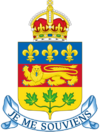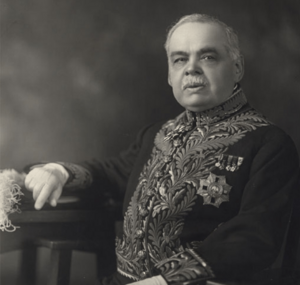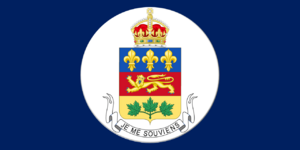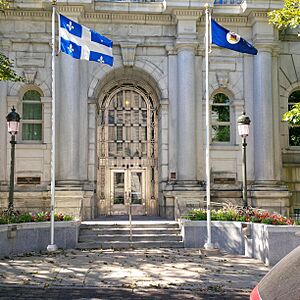Lieutenant Governor of Quebec facts for kids
Quick facts for kids Lieutenant Governor of Quebec |
|
|---|---|

Standard of the lieutenant governor
|
|

Coat of arms of Quebec
|
|
| Office of the Lieutenant Governor of Quebec | |
| Style | Her Honour the Honourable |
| Appointer | The governor general on the advice of the prime minister |
| Term length | At the governor general's pleasure |
| Formation | July 1, 1867 |
| First holder | Sir Narcisse-Fortunat Belleau |
The lieutenant governor of Quebec is a very important person in Quebec. They represent the monarch (the King or Queen of Canada) in the province. This role is similar to how the King or Queen is represented in other Canadian provinces.
The lieutenant governor is chosen by the governor general (who represents the monarch for all of Canada). This choice is made based on advice from the prime minister. The lieutenant governor helps carry out many of the monarch's official duties in Quebec. The current lieutenant governor of Quebec is Manon Jeannotte. She started in this role on January 25, 2024.
Contents
What Does the Lieutenant Governor Do?
The lieutenant governor of Quebec has many important jobs. These include both official government duties and special public appearances.
Government Responsibilities
The lieutenant governor performs several key tasks related to the government of Quebec. For example, they give Royal Assent to new laws. This means they officially approve laws passed by the provincial parliament. Without their approval, a bill cannot become a law.
Unlike other Canadian viceroys, the lieutenant governor of Quebec does not give the Throne Speech. This speech usually outlines the government's plans. In Quebec, the premier gives the opening speech for new parliaments instead.
Ceremonial Duties and Public Events
The lieutenant governor also takes part in many special events and ceremonies. They are often the host or a special guest. These events can include:
- Presenting provincial honours and awards to people who have done great things for Quebec.
- Attending community events, school visits, and cultural celebrations.
- Meeting with different groups and citizens from across the province.
For example, in 2006, the lieutenant governor of Quebec attended 400 events! These public appearances help connect the government with the people.
Special Honours and Awards
The lieutenant governor automatically becomes a Knight or Dame of Justice. They also become the Vice-Prior in Quebec of the Most Venerable Order of the Hospital of Saint John of Jerusalem. This is an old and respected organization. Many other provincial honours are given out by the lieutenant governor. These awards were brought back in 2000 by Lieutenant Governor Lise Thibault.
The Lieutenant Governor's Flag
When the lieutenant governor is at an event, their special flag is often displayed. This flag is called the lieutenant governor's standard. It has a blue background with the Coat of Arms of Quebec in the middle. The Quebec viceregal flag is unique compared to most other similar flags in Canada.
Order of Importance in Quebec
In Quebec, the lieutenant governor is second in importance only to the monarch. They are even more important than other members of the Canadian Royal Family or the governor general when they are in Quebec. This shows how important their role is within the province.
A Look at History
The role of the lieutenant governor of Quebec began in 1867. This was when Quebec became a province as part of Confederation. Since then, 28 people have served in this important position.
Notable Lieutenant Governors
Some lieutenant governors have made history. For example, Lise Thibault was the first woman to hold the position. She was also the first lieutenant governor with a disability.
The person who served the shortest time as lieutenant governor was Lomer Gouin. He was in office from January to March 1929. The longest-serving lieutenant governor was Hugues Lapointe, who held the role from 1966 to 1978.

A Special Case in 1887
In 1887, Lieutenant Governor Auguste-Réal Angers made a very rare decision. He removed the government led by Premier Honoré Mercier. This happened after a report suggested that Mercier's government had benefited from a special arrangement with contractors building a railway. This was one of the few times a lieutenant governor in Canada acted against the advice of the premier.
Where Does the Lieutenant Governor Work?
Since 1997, the lieutenant governor of Quebec has not had an official home. They live in their own homes in or near the capital city, Quebec City. However, they still have an official office. This office is located at the Édifice André-Laurendeau building.
In the past, there were official residences. These included Maison Sewell and Spencer Wood. Spencer Wood was used from 1870 to 1966 but was destroyed by a fire.
Images for kids
See also
- Monarchy in the Canadian provinces
- Government of Quebec
- Lieutenant Governors of Canada






